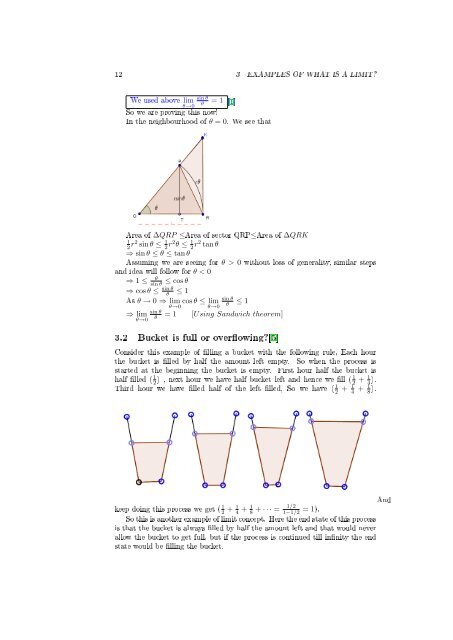Denition approach of learning new topics
You also want an ePaper? Increase the reach of your titles
YUMPU automatically turns print PDFs into web optimized ePapers that Google loves.
12 3 EXAMPLES OF WHAT IS A LIMIT?<br />
We used above lim<br />
θ→0<br />
sin θ<br />
θ<br />
= 1 [1]<br />
So we are proving this now!<br />
In the neighbourhood <strong>of</strong> θ = 0. We see that<br />
Area <strong>of</strong> ∆QRP ≤Area <strong>of</strong> sector QRP≤Area <strong>of</strong> ∆QRK<br />
1<br />
2 r2 sin θ ≤ 1 2 r2 θ ≤ 1 2 r2 tan θ<br />
⇒ sin θ ≤ θ ≤ tan θ<br />
Assuming we are seeing for θ > 0 without loss <strong>of</strong> generality, similar steps<br />
and idea will follow for θ < 0<br />
⇒ 1 ≤<br />
θ<br />
sin θ ≤ cos θ<br />
⇒ cos θ ≤ sin θ<br />
θ<br />
≤ 1<br />
sin θ<br />
As θ → 0 ⇒ lim cos θ ≤ lim<br />
θ→0 θ→0<br />
θ<br />
≤ 1<br />
sin θ<br />
⇒ lim<br />
θ→0<br />
θ<br />
= 1 [Using Sandwich theorem]<br />
3.2 Bucket is full or overowing?[5]<br />
Consider this example <strong>of</strong> lling a bucket with the following rule, Each hour<br />
the bucket is lled by half the amount left empty. So when the process is<br />
started at the beginning the bucket is empty. First hour half the bucket is<br />
half lled ( 1 2 ) , next hour we have half bucket left and hence we ll ( 1 2 + 1 4 ).<br />
Third hour we have lled half <strong>of</strong> the left lled, So we have ( 1 2 + 1 4 + 1 8 ). And<br />
keep doing this process we get ( 1 2 + 1 4 + 1 8 + · · · = 1/2<br />
1−1/2 = 1).<br />
So this is another example <strong>of</strong> limit concept. Here the end state <strong>of</strong> this process<br />
is that the bucket is always lled by half the amount left and that would never<br />
allow the bucket to get full, but if the process is continued till innity the end<br />
state would be lling the bucket.



